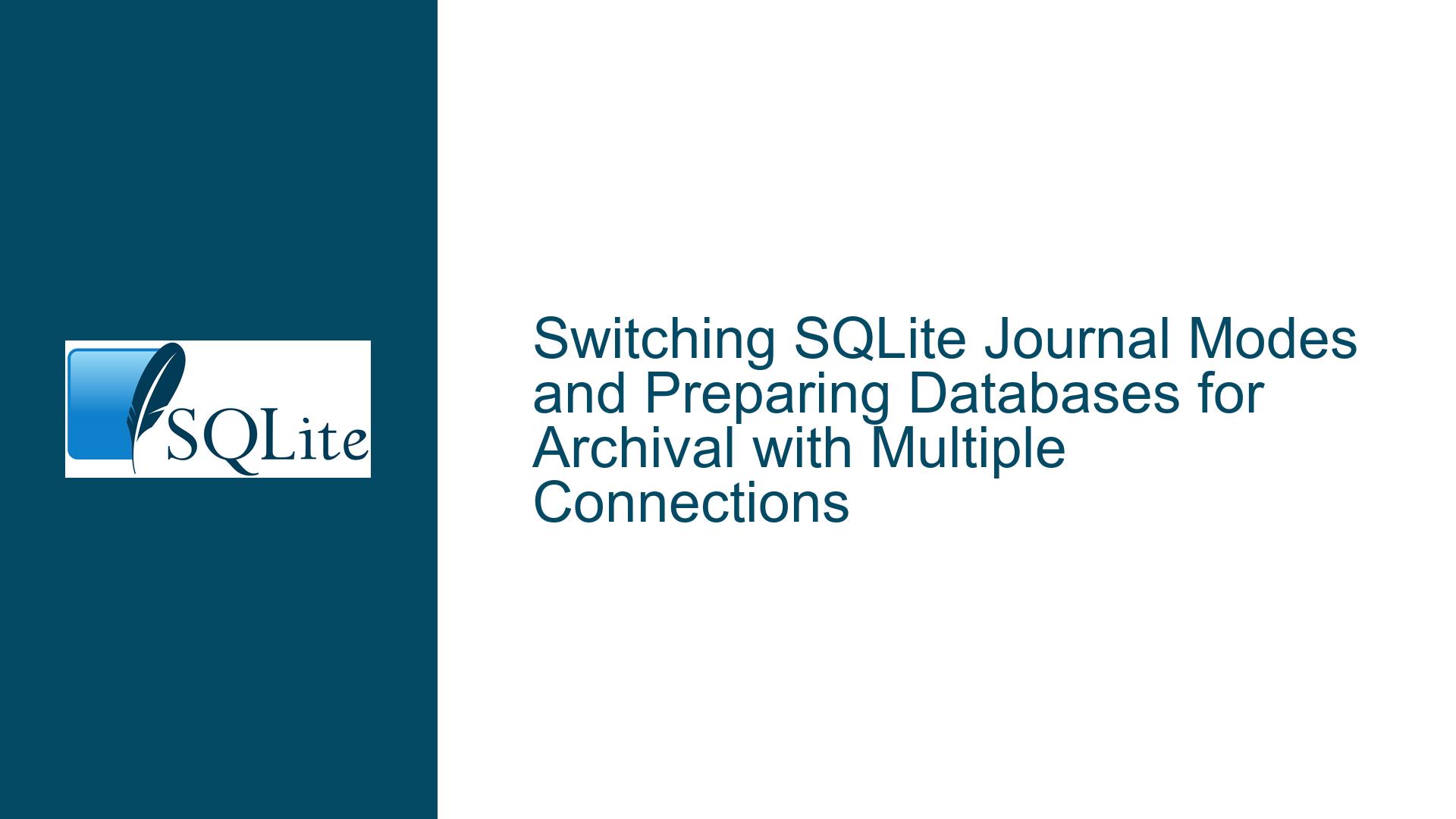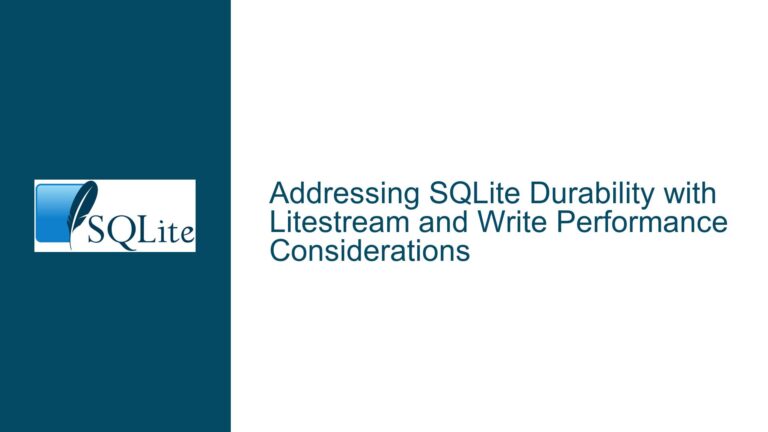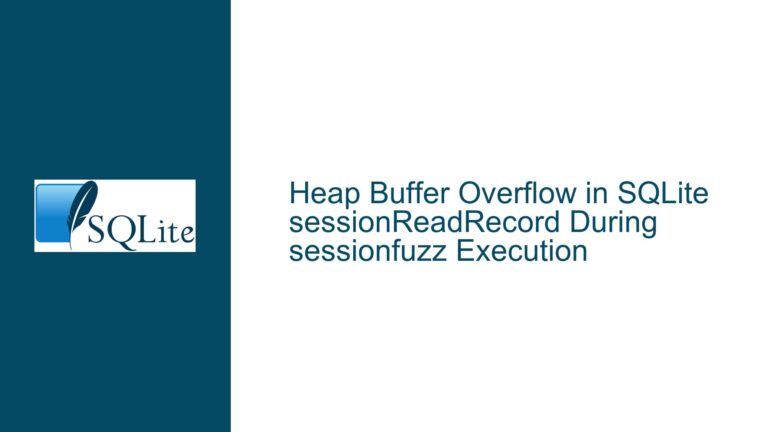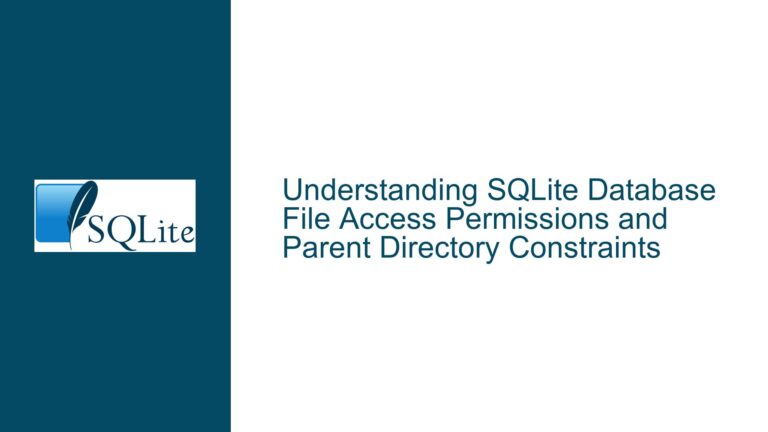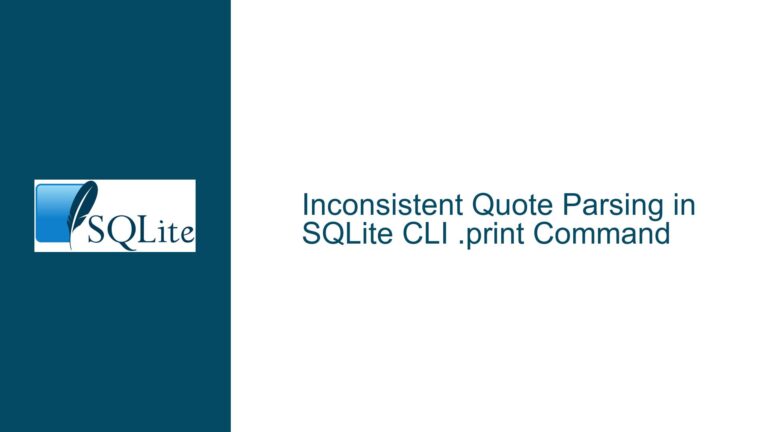Switching SQLite Journal Modes and Preparing Databases for Archival with Multiple Connections
Issue Overview: Switching Journal Modes and Archival Preparation in SQLite
When working with SQLite databases, particularly in applications that require periodic archival, managing journal modes and ensuring database consistency can become a complex task. The core issue revolves around the interplay between SQLite’s Write-Ahead Logging (WAL) mode and the traditional rollback journal mode (DELETE), especially when multiple connections to the database are active. The primary goal is to prepare the database for archival in a way that guarantees consistency, ensuring that no transient files like .wal or .shm are included in the archived copy. This is crucial for maintaining data integrity, particularly when the database is being moved to long-term storage or read-only media.
The challenge arises when attempting to switch the journal mode from WAL to DELETE while multiple connections to the database are still open. SQLite’s design enforces strict rules around journal mode changes to prevent data corruption, and these rules become particularly relevant in multi-connection scenarios. The issue is further complicated by the fact that some connections may originate from the same thread or process, which introduces additional nuances in how SQLite handles locks and journal mode transitions.
The overarching problem can be broken down into several key questions: Is it safe to switch the journal mode from WAL to DELETE while multiple connections are open? Does the situation change if these connections are from the same thread or process? Are there workarounds or best practices to mitigate potential pitfalls, such as handling SQLITE_BUSY errors? Finally, what is the most effective method to prepare a database for archival when multiple connections are present, and how can this be achieved without risking data inconsistency or corruption?
Possible Causes: Why Journal Mode Switching and Archival Preparation Fail with Multiple Connections
The root cause of the issues described lies in SQLite’s concurrency model and its handling of journal modes. SQLite employs different locking mechanisms depending on the journal mode in use. In WAL mode, SQLite uses a shared-memory file (.shm) and a write-ahead log file (.wal) to manage concurrent reads and writes. This allows multiple readers and a single writer to operate simultaneously without blocking each other, significantly improving performance in multi-connection scenarios. However, this also means that the database file itself is not immediately updated with the latest changes; instead, these changes are stored in the .wal file until a checkpoint operation merges them back into the main database file.
When switching from WAL to DELETE mode, SQLite must ensure that all changes in the .wal file are checkpointed into the main database file and that no active connections are relying on the WAL mechanism. This is a critical operation that requires exclusive access to the database. If multiple connections are open, SQLite cannot guarantee that all connections have released their locks on the .wal and .shm files, leading to potential conflicts and errors. Specifically, attempting to switch journal modes while other connections are active will result in an SQLITE_BUSY error, as SQLite cannot safely perform the transition without risking data corruption.
The situation is further complicated when connections originate from the same thread or process. While SQLite’s locking mechanisms are designed to handle multi-process concurrency, intra-process concurrency introduces additional challenges. For example, connections from the same thread may share certain resources, such as file handles, which can lead to unexpected behavior when attempting to switch journal modes. Even if all connections are from the same thread, SQLite’s internal locking mechanisms still enforce strict rules to prevent data corruption, meaning that the same restrictions apply.
Another contributing factor is the lack of a built-in mechanism in SQLite to force all connections to release their locks or to coordinate journal mode changes across connections. This makes it difficult to implement a robust solution for switching journal modes in multi-connection scenarios without resorting to external coordination mechanisms, such as application-level locking or connection pooling.
Troubleshooting Steps, Solutions & Fixes: Best Practices for Archival Preparation and Journal Mode Management
To address the challenges of switching journal modes and preparing a database for archival in multi-connection scenarios, several strategies can be employed. These strategies range from leveraging SQLite’s built-in features to implementing application-level coordination mechanisms.
1. Use VACUUM INTO for Archival Preparation
The most effective solution for preparing a database for archival is to use SQLite’s VACUUM INTO command. This command creates a new database file that contains all the data from the original database but excludes any transient files like .wal or .shm. The VACUUM INTO command is specifically designed for this purpose and can be executed even when multiple connections to the original database are active. This eliminates the need to switch journal modes before archival, as the new database file is created in a consistent state.
To use VACUUM INTO, simply execute the following SQL command:
VACUUM INTO 'path/to/archive.db';
This will create a new database file at the specified path, which can then be safely archived. The original database remains unaffected, and there is no risk of data corruption or inconsistency.
2. Avoid Switching Journal Modes with Multiple Connections
As a general rule, avoid switching the journal mode from WAL to DELETE while multiple connections are open. This operation is inherently risky and can lead to SQLITE_BUSY errors or even data corruption. Instead, rely on VACUUM INTO to create a consistent copy of the database for archival purposes. If you must switch journal modes, ensure that all connections to the database are closed before performing the switch. This can be achieved by implementing a connection management system that tracks and closes all active connections before initiating the journal mode change.
3. Implement Application-Level Coordination
In scenarios where closing all connections is not feasible, implement application-level coordination mechanisms to ensure that journal mode changes are performed safely. For example, you can use a global lock or semaphore to prevent new connections from being opened while the journal mode is being switched. Additionally, you can implement a retry mechanism to handle SQLITE_BUSY errors, although this approach is less reliable and should be used with caution.
4. Monitor and Manage Connection Lifetimes
To minimize the risk of conflicts during archival preparation, carefully monitor and manage the lifetimes of database connections. Use connection pooling to limit the number of active connections and ensure that connections are closed as soon as they are no longer needed. This reduces the likelihood of encountering SQLITE_BUSY errors and makes it easier to coordinate journal mode changes or archival operations.
5. Leverage SQLite’s Checkpointing Mechanism
If you must work with WAL mode and need to ensure that all changes are merged into the main database file before archival, use SQLite’s checkpointing mechanism. The PRAGMA wal_checkpoint command can be used to force a checkpoint operation, which merges the changes from the .wal file into the main database file. This can be useful in scenarios where you want to minimize the size of the .wal file before archival, although it does not eliminate the need for VACUUM INTO.
6. Test and Validate Archival Procedures
Finally, thoroughly test and validate your archival procedures to ensure that they work as expected in all scenarios. This includes testing with multiple connections, different journal modes, and various workloads. Use tools like SQLite’s PRAGMA integrity_check to verify the consistency of the archived database and ensure that no transient files are included in the archive.
By following these best practices, you can effectively manage journal modes and prepare SQLite databases for archival in multi-connection scenarios, ensuring data consistency and integrity without risking corruption or errors.
